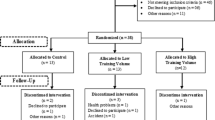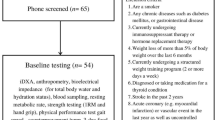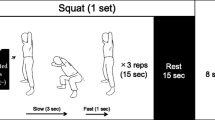Abstract
The effect of exercise modalities on determinants of sarcopenia, specifically, lean tissue mass, maximal voluntary isometric contraction (MVIC), muscle quality (MQ), and cardiorespiratory fitness (VO2peak) over 12 weeks were studied in 42 (45–55 years, 60 days of amenorrhea, with ≤1 h/week physical activity) perimenopausal females. Subjects were assigned to strength training (super-slow, 20 s tension, STss = 7; hypertrophy, 2–4 s tension, STht = 8), endurance training (intermittent, ≥48 h rest, ETi = 7; consecutive, 24 h, ETc = 9) and autogenic training group (AT = 11). ST and ET met 60 min day−1, 3 days week−1 and AT 1 day week−1. Leg extension, incremental cycling with gas exchange, dual-energy X-ray absorptiometry, and blood analysis were tested. The MANOVA revealed that STss improved MVIC (P < 0.01) and MQ (P ≤ 0.01). The VO2peak also increased significantly in ET group by 28% (ETi: P = 0.02, ETc: P = 0.01). A modality-specific effect on strength, MQ, and VO2peak in perimenopausal females was duly noted.



Similar content being viewed by others
References
Borst SE (2004) Interventions for sarcopenia and muscle weakness in older people. Age Ageing 3(6):548–555. doi:10.1093/ageing/afh201
Brochu M, Svage P, Lee M, Dee J, Cress ME, Poehlman ET, Tischler M, Ades PA (2002) Effects of resistance training on physical function in older disabled women with coronary heart disease. J Appl Physiol 92:672–678. doi:10.1063/1.1481961
Burger HG, Dudley EC, Robertson DM, Dennerstein L (2002) Hormonal changes in the menopause transition. Recent Prog Horm Res 57:257–275. doi:10.1210/rp.57.1.257
Doherty TJ (2003) Invited review: aging and sarcopenia. J Appl Physiol 65:1717–1727
Fitzgerald MD, Tanaka H, Tran ZV, Seals DR (1997) Age-related declines in maximal aerobic capacity in regularly exercising vs. sedentrary women: a meta-analysis. Am Physiol Soc 83(1):160–165
Frontera WR, Hughes VA, Lutz KJ, Evans WJ (1991) A cross-sectional study of muscle strength and mass in 45- to 78-yr-old men and women. J Appl Physiol 71(2):644–650
Frontera WR, Hughes VA, Fielding RA, Fiatarone MA, Evans WJ, Roubenhoff R (2000) Aging of skeletal muscle: a 12-yr longitudinal study. J Appl Physiol 88:1321–1326
Galvao DA, Taaffe DR (2004) Single- vs. multiple-set resistance training: recent developments in the controversy. J Strength Cond Res 18(3):660–667. doi:10.1519/1533-4287(2004)18<660:SVMRTR>2.0.CO;2
Grommas R (1997) Standardisierung eines messtechnischen Verfahrens zur Überprüfung der isometrischen Maximalkraft. [Validation of a test to assess the maximum voluntary isometric contraction.] Thesis, University of Salzburg, Department of Sport Science and Kinesiology, Salzburg
Heinonen A, Oja P, Sievänen H, Pasanen M, Vuori I (1998) Effect of two training regimens on bone mineral density in healthy perimenopausal women: a randomized controlled trial. J Bone Miner Res 13:483–490. doi:10.1359/jbmr.1998.13.3.483
Kaikkonen H, Yrjämä M, Siljander E, Byman P, Laukkanen R (2000) The effect of HR controlled low resistance circuit weight training and endurance training on maximal aerobic power in sedentary adults. Scand J Med Sci Sports 10:211–215. doi:10.1034/j.1600-0838.2000.010004211.x
Kemmler WK, Lauber D, Engleke K, Weineck J (2004) Effects of single- vs. multiple-set resistance training on maximum strength and body composition in trained postmenopausal women. J Strength Cond Res 18(4):689–694. doi:10.1519/R-16164.1
Kemmler W, von Stengel S, Weineck J, Laber D, Klaender W, Engelke K (2005) Exercise effect on menopausal risk factors of early postmenopausal women: 3-yr Erlangen fitness osteoporosis prevention study results. Med Sci Sports Exerc 37(2):194–203. doi:10.1249/01.MSS.0000152678.20239.76
Levine JA, Abboud L, Barry M, Reed JE, Sheedy PF, Jensen MD (2000) Measuring leg muscle and fat mass in humans: comparison of CT and dual-energy X-ray absorptiometry. J Appl Physiol 88:452–456
Lindle RS, Metter EJ, Lynch NA, Fleg JL, Fozard JL, Tobin J, Roy TA, Hurley BF (1997) Age and gender comparisons of muscle strength in 654 women and men aged 20–93 yr. J Appl Physiol 83(5):1581–1587
Lynch NA, Metter EJ, Lindle RS, Fozard JL, Tobin JD, Roq TA, Fleg JL, Hurley BF (1999) Muscle quality I age-associated differences between arm and leg muscle groups. J Appl Physiol 86(1):188–194
Macaluso A, Young A, Gibb KS, Rowe DA, DeVito G (2003) Cycling as a novel approach to resistance training increases muscle strength, power, and selected functional abilities in healthy older women. J Appl Physiol 95:2544–2553
Miszko TA, Cress ME (2000) Exercise in the perimenopausal and postmenopausal women. Clin Sports 19:215–232. doi:10.1016/S0278-5919(05)70200-3
Orsatti FL, Nahas EAP, Maesta N, Nahas-Neto J, Burini RC (2008) Plasma hormones, muscle mass and strength in resistance-trained postmenopausal women. Maturitas 59:394–404. doi:10.1016/j.maturitas.2008.04.002
Randolph JF, Crawford S, Dennerstein L, Cain K, Harlow SD, Little R, Mitchell ES, Nan B, Taffe J, Yosef M (2006) The value of follicle-stimulation hormone concentration and clinical findings as markers of the late menopausal transition. J Clin Endocrinol Metab 91:3034–3040. doi:10.1210/jc.2006-0243
Rantanen T, Sakari-Rantala R, Heikkinen E (2002) Muscle strength before and mortality after a bone fracture in older people. Scand J Med Sci Sports 12:296–300. doi:10.1034/j.1600-0838.2002.102100.x
Sanada K, Kuchiki T, Miyachi M, McGrath K, Higuchi M, Ebashi H (2007) Effects of age on ventilatory threshold and peak oxygen uptake normalized for regional skeletal muscle mass in Japanese men and women aged 20–80 years. Eur J Appl Physiol 99:475–483. doi:10.1007/s00421-006-0375-6
Schultz JH, Luthe W (1969). Autogenic therapy, vol I. Autogenic methods. Grune & Stratton, New York
Signorile JF, Carmel MP, Lai S, Roos BA (2005) Early plateaus of power and torque gains during high- and low-speed resistance training of older women. J Appl Physiol 98:1213–1220. doi:10.1152/japplphysiol.00742.2004
Sorensen MB (2002) Changes in body composition at menopause-age, lifestyle or hormone deficiency? J Br Menopause Soc 8:137–140. doi:10.1258/136218002100321974
Starkey DB, Pollock ML, Ishida Y, Welsch MA, Brechue WF, Graves JE, Feigenbaum MS (1996) Efffect of resistance training volume on strength and muscle thickness. Med Sci Sports Exerc 28(10):1311–1320. doi:10.1097/00005768-199610000-00016
Stetter F, Kupper S (2002) Autogenic training: a meta-analysis of clinical outcome studies. Appl Psychophysiol Biofeedback 27(1):45–98. doi:10.1023/A:1014576505223
Taaffe DR (2006) Sarcopenia. Exercise as a treatment strategy. Aust Fam Phys 35(3):130–134
Tracy BL, Ivey FM, Hurlbut D, Matel GF, Lemmer JT, Siegel EL, Metter EJ, Fozard JL, Fleg JL, Hurley BF (1999) Muscle quality. II. Effects of strength training in 65- to 75-yr-old men and women. J Appl Physiol 86(1):195–201
Westcott WL, Winett RA, Anderson ES, Wojcik JR, Loud RL, Cleggett E, Glover S (2001) Effects of regular and slow speed resistance training on muscle strength. J Sports Med Phys Fitness 41(2):154–158
Zijdewind I, Toering ST, Bessem B, Van der Laan O, Diercks RL (2003) Effects of imagery motor training on torque production of ankle plantar flexor muscles. Muscle Nerve 28:168–173. doi:10.1002/mus.10406
Acknowledgments
We wish to express our gratitude to the sports scientists Julia Wiltschko (ET), Martina Brückl (ST), Florian Furtner (ST), and Barbara Hoeller (AT). Special thanks go to Sieglinde Graf for completing the DXA measurements and to Holger Förster, Walter Stoiber, and Martin Hudelmaier for their expertise throughout the study.
Author information
Authors and Affiliations
Corresponding author
Rights and permissions
About this article
Cite this article
Ring-Dimitriou, S., Steinbacher, P., von Duvillard, S.P. et al. Exercise modality and physical fitness in perimenopausal women. Eur J Appl Physiol 105, 739–747 (2009). https://doi.org/10.1007/s00421-008-0956-7
Accepted:
Published:
Issue Date:
DOI: https://doi.org/10.1007/s00421-008-0956-7




